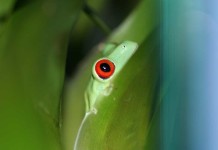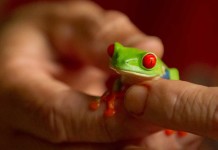The red eyed tree frog is a dazzling creature that attracts much attention throughout the world due to its vibrant red eyes, bold green skin and orange legs. It is not only visually amazing, but the red eyed tree frog is a creature of interesting habits. To acquaint you better with the red eyed tree frog, following is a summary of red eyed tree frog information.
Characteristics
The scientific name for the red eyed tree frog is agalychnis callidryas, which in Greek means beautiful tree/wood nymph. The frog was discovered in Panama by Edward D. Cope in 1862. They reside in the rainforests throughout Central America and in northern South America.
The red eyed tree frog is a nocturnal, arboreal amphibian. They spend the day resting or sleeping on the underside of leaves in the rainforest. At night, they awaken and hunt for food. They are relatively small in size, ranging from 1” to 2”, with the female being the largest.
They are bright lime green with blue and yellow flank stripes. Their lower thighs and feet are bright orange. Their eyes, for what they are named, are bright red with elliptical pupils. Their skin is very porous, which allows them to absorb water. They drink through their skin and this also helps with their breathing. They have three eyelids, one of which provides camouflage to their bright red eyes.
Natural Defense
 Some of the most interesting red eyed tree frog information relates to its innate sense of danger and its incredible natural defenses. The red eyed tree frog’s primary predators are bats, snakes, birds and even other frogs. If a predator approaches the red eyed tree frog during the day, it will encounter a small green frog that almost perfectly blends in with the leave onto which it clings.
Some of the most interesting red eyed tree frog information relates to its innate sense of danger and its incredible natural defenses. The red eyed tree frog’s primary predators are bats, snakes, birds and even other frogs. If a predator approaches the red eyed tree frog during the day, it will encounter a small green frog that almost perfectly blends in with the leave onto which it clings.
However, when the red eyed tree frog senses the predator, it will quickly open its eyes to reveal big, bright red orbs that will startle the predator. Additionally, the frog takes its legs from under its belly to show off its bright blue and yellow side strips and orange feet. The predator pauses, startled by the sudden burst of color. This is known as startle coloration and gives the red eyed tree frog the moment it needs to escape to safety.
Feeding
The red eyed tree frog feeds at night on flies, moths, crickets and sometimes other frogs. It hunts for prey or just silently waits for prey to approach. Once a tasty tidbit is sighted, the frog flicks it lightning-fast tongue out and catches the unsuspecting prey. The red eyed tree frog must eat relatively small insects because it has no teeth.
This is some of the most interesting red eyed tree frog information. They are a wonderful creature that has had millions of years to adapt to its environment of the rainforests. The threats it faces are the declining rainforests, certain diseases and, of course, natural predators. The red eyed tree frog is the most colorful amphibian and is truly remarkable to observe.
Red Eyed Tree Frog in Australia
The beautiful amphibian that resides in the rainforests and wetlands of North Eastern Queensland
Interesting Facts of Red Eyed Frog
Only these facts can tell you that how interesting this creature is.
Is the Red Eyed Tree Frog Poisonous?
The fact that most of the pet hobbyists need to find out.
Amazing Grip of The Frog’s Feet
The feet are amazing, providing colorful defense and allowing the frog to cling securely to surfaces
The Wonder of Red Eyed Frog Skin
The skin creates distraction against predators and provide the moisture and oxygen the frog needs.
Dangers of Red Eyed Tree Frog in Its Habitat
The frogs are in danger due to pollution, development and climate changes.
Pet Frog for Kids is a Learning Process
It can be made fun and enjoyable for the whole family, ensuring the proper care of the frog.













